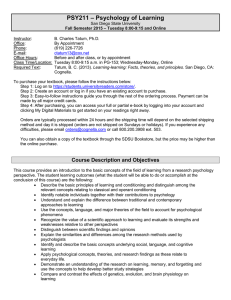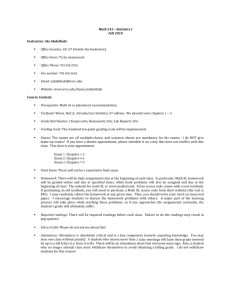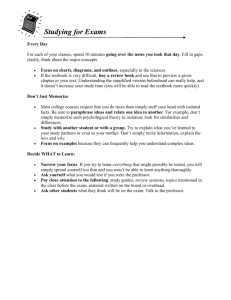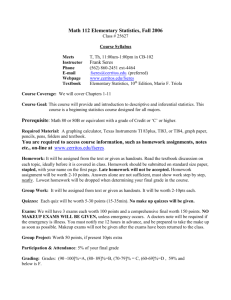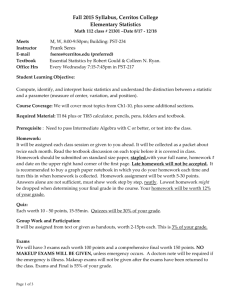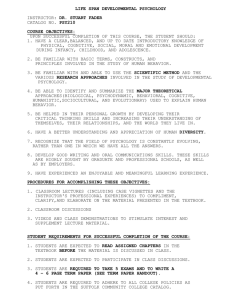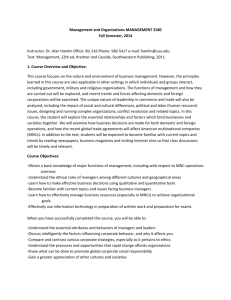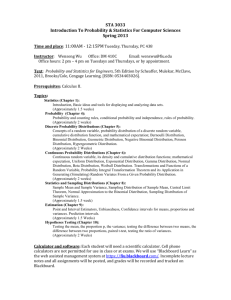PSY 211 – Psychology of Learning
advertisement
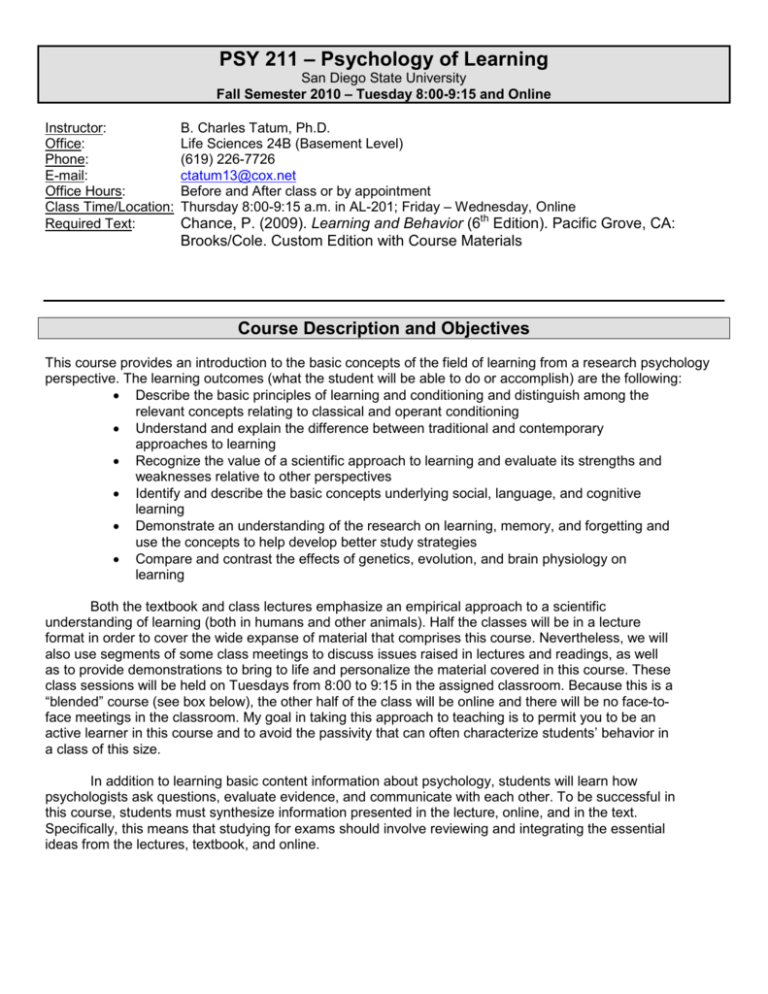
PSY 211 – Psychology of Learning San Diego State University Fall Semester 2010 – Tuesday 8:00-9:15 and Online Instructor: Office: Phone: E-mail: Office Hours: Class Time/Location: Required Text: B. Charles Tatum, Ph.D. Life Sciences 24B (Basement Level) (619) 226-7726 ctatum13@cox.net Before and After class or by appointment Thursday 8:00-9:15 a.m. in AL-201; Friday – Wednesday, Online Chance, P. (2009). Learning and Behavior (6th Edition). Pacific Grove, CA: Brooks/Cole. Custom Edition with Course Materials Course Description and Objectives This course provides an introduction to the basic concepts of the field of learning from a research psychology perspective. The learning outcomes (what the student will be able to do or accomplish) are the following: • Describe the basic principles of learning and conditioning and distinguish among the relevant concepts relating to classical and operant conditioning • Understand and explain the difference between traditional and contemporary approaches to learning • Recognize the value of a scientific approach to learning and evaluate its strengths and weaknesses relative to other perspectives • Identify and describe the basic concepts underlying social, language, and cognitive learning • Demonstrate an understanding of the research on learning, memory, and forgetting and use the concepts to help develop better study strategies • Compare and contrast the effects of genetics, evolution, and brain physiology on learning Both the textbook and class lectures emphasize an empirical approach to a scientific understanding of learning (both in humans and other animals). Half the classes will be in a lecture format in order to cover the wide expanse of material that comprises this course. Nevertheless, we will also use segments of some class meetings to discuss issues raised in lectures and readings, as well as to provide demonstrations to bring to life and personalize the material covered in this course. These class sessions will be held on Tuesdays from 8:00 to 9:15 in the assigned classroom. Because this is a “blended” course (see box below), the other half of the class will be online and there will be no face-toface meetings in the classroom. My goal in taking this approach to teaching is to permit you to be an active learner in this course and to avoid the passivity that can often characterize students’ behavior in a class of this size. In addition to learning basic content information about psychology, students will learn how psychologists ask questions, evaluate evidence, and communicate with each other. To be successful in this course, students must synthesize information presented in the lecture, online, and in the text. Specifically, this means that studying for exams should involve reviewing and integrating the essential ideas from the lectures, textbook, and online. 2 Blended/Hybrid Classes This course is a blended learning (or “hybrid”) course. This means that we will conduct half of the sessions in a typical, face-to-face lecture format, as noted above. We will cover some of the class material online using the Blackboard online platform. The online activities are noted in the Course Schedule below. They are labeled as “Online” (and highlighted in orange if you have a color printer). NOTE THAT ON THE DATES LABELED AS ONLINE WE WILL NOT HAVE A FACE-TO-FACE CLASS MEETING IN THE CLASSROOM. The purpose of the online portion of the class is to give you an opportunity to be an active learner. None of the online activities are REQUIRED. What you do and when you do it is your choice. Watch the videos, do the exercises, try the sample questions, post comments on the discussion board whenever you like (3:00 a.m. is fine if you are a night owl). I will be logging on throughout the week just to see what has been posted on the Discussion Board and decide if I need to respond (Note: I will not respond to requests to define terms or address questions that have been clearly covered in class or the textbook. If you have come to class and read the text and are still confused, I will do what I can to give you more examples or elaborate on issues). Blackboard is there to supply you with additional study material (videos, exercises, sample questions, discussion board, PowerPoint slides) that you can access at your convenience. You do not have to drive through the traffic to come to class. All of the online instruction can be done at any time between the scheduled class meetings. Some students have had other online or “blended” courses and they had to meet at specific times for an “online class” (using Wimba or some other synchronous program). We will NOT be doing that so don’t worry about class meetings other than the ones on the schedule. Exams There will be three required exams and one optional final during the semester. The dates of these exams are noted in the Course Schedule included below. Each exam will be worth 50 points. Each exam will consist of 50 multiple-choice and true-false questions (1 point each). The exams will cover each section of the course independently: Exams 1-3 are not cumulative. The Optional Final Exam is cumulative. All test questions will come from lectures, videos, and readings in the textbook. Any portion of the lectures, videos, or assigned readings may be covered on the tests. You MUST read the textbook. Your textbook reading should be an essential complement to the material covered in the lectures. For each of the four tests, you will need to bring your own answer sheet. The correct answer sheet for Exam 1 is ParScore #F-288 (this is the wide Scantron sheet). All other exams will use ParScore #F-289 (the narrow Scantron sheet) PLEASE NOTE THERE ARE NO MAKE-UP EXAMS. TAKE THE EXAMS ON THE DAY THAT THEY ARE GIVEN. IF YOU MISS AN EXAM YOU CAN TAKE THE OPTIONAL FINAL TO MAKE UP LOST POINTS. Sample Questions Each week there will be sample questions that you can answer online. You may use your textbook or any other materials, including your class notes, to assist you in completing the on-line questions. The object of these short quizzes is (a) to allow you to test yourself to see how well you have mastered the material, and (b) to give you some idea of what the exam items are like (don’t be 3 surprised if some of the items on the exam are very similar to the items on the sample quizzes). Your best strategy for taking the quizzes is to study the class materials but do not use them when you answer the questions. If you do well without consulting the material, then you can be assured that you know the information. If you do poorly, then it is time for more review. Course Requirements Your grade in the class will be determined by your performance on three, non-cumulative examinations and one optional final exam (cumulative for the semester). The exams will draw on material from both the text and class (classroom or online). The exams will consist of objective style questions (multiple choice, true/false) graded electronically. Each exam will be weighted equally and will determine onethird of your final grade. If you choose to take the final exam, your grade will be determined by the three highest exam scores. That means that if you do poorly on one of the first three exams (or miss an exam), you can improve you grade by doing well on the final exam. The final exam can only improve your grade, it cannot hurt you. I encourage everyone to take the optional final. Grading A total of 150 points is possible. You can keep track and determine your grade using these tables. Points Possible Your Points Exam 1 Exam 2 Exam 3 Optional (Cumulative) Final 50 50 50 50 TOTAL 150 Points on Single Exam 47-50 45-46 43-44 41-42 40 38-39 36-37 35 33-34 31-32 30 Less than 30 Grade Percent A AB+ B BC+ C CD+ D DF 93-100 90-92 87-89 83-86 80-82 77-79 73-76 70-72 67-69 63-676 60-62 Less than 60 If this score is higher than the lowest of the three scores for Exam 1-3, replace the lowest score with this one. Points for Entire Class 140-150 135-139 131-134 125-130 120-124 116-119 110-115 105-109 101-104 95-100 90-94 Less than 90 4 General Course Policies (1). Make-Up Exams: There are no make-up exams. If you miss an exam (because of illness, emergency, prior commitment, etc.) you can take the optional final to make up for the lost points. (2). Extra Credit: Your grade is determined by your performance on the exams. Because of the size of this class, extra credit assignments are not an option. If you need an opportunity to make up for poor performance on an exam, take the optional final. (3). Office Hours: I am a part-time instructor and so my office hours are very limited. If you need to contact me outside of class, you may call me at home. If you need to see me in person, we can arrange to meet 30 minutes before class, immediately after class, or by appointment. (4). Class Attendance: I will not take attendance and so your presence in class is strictly voluntary. Much of the material on the exams will come from the class sessions, and this information cannot be obtained from the textbook or online. Therefore, the incentive to come to class is not only the pleasure of my brilliant class presentations, but also better test performance. (5). Blackboard: The syllabus and handouts are posted on Blackboard. Your exam scores will also be posted on Blackboard. Important class notices will appear occasionally. Finally, video tapes, sample questions, exercises, and a discussion board will be available on Blackboard. (6). Study Aids: There is a Study Guide for each exam in the course materials (available online in Blackboard). The textbook supplies many study supports (e.g., practice quizzes, review questions, in-chapter queries, bold-faced terms) and there will be sample questions on Blackboard. (7). Textbook: It is library policy not to carry textbooks in their holdings, and I do not have an extra textbook that I can put on reserve. The textbook is a vital part of this course and I urge you to obtain one. If you cannot afford a new book, you can buy one used, borrow one from another student, or form a collective and purchase a group book. (8). Grading Scale: Grades are based on a standard percentage scale shown above. Each of the three exams is worth 50 points, and your final grade for the class will be based on the percentage of the total 150 points you earn. (You may also take the optional final if you want to improve your point total; a high score on the final will replace your lowest exam score.) I sometimes curve the grades downward (i.e., lower the cut-off points to make it easier to get a higher grade) if I feel that the class is having difficulty with the material. However, I do not do this until all of the grades are in at the end of the semester, so please do not ask if I will curve the grades prior to the final exam because I will not know. (9). Requests for Grade Changes: Once grades are posted they are final. Do not ask me to change your grade unless there has clearly been an error in the calculation of your grade. In the interest of fairness to all students, I must assign grades based on exam performance and cannot make exceptions regardless of the circumstance. 5 Academic Integrity Academic integrity is one of the fundamental principles of a university community. San Diego State University expects the highest standards of academic honesty from all students. Violations of academic integrity include the following: (a) unauthorized assistance on an examination, (b) falsification or invention of data, (c) unauthorized collaboration on an academic exercise, (d) plagiarism, (e) misappropriation of research materials, (f) unauthorized access of an instructor’s files or computer account, and (g) any other serious violation of academic integrity as established by the instructor. If your academic integrity is not maintained on a test or assignment, you will automatically receive a grade of zero for that test or assignment and you will be reported to the Dean’s Office in accordance with SDSU academic integrity policy. Penalties can be severe. More specific information is available in the SDSU Bulletin, both in print and on-line. Students with Disabilities Students who need accommodation of their disabilities should contact me privately to discuss specific accommodations for which they have received authorization. If you have a disability, but have not contacted Student Disability Services at 619-594-6473 (Calpulli Center, Suite 3101), please do so before making an appointment to see me. The web site for Student Disability Services is: http://www.sa.sdsu.edu/sds/index.html Recommended Study Strategies (Based on Learning Principles) Class Preparation Read the material in the text prior to class Do the “Practice Quiz” at the end of the chapter (sometimes we won’t read all of the chapter, so just do the quiz for the assigned material) Come to all class sessions Pay attention in class and take notes Ask questions in class and post items on the online discussion board (there are no dumb questions from students, just an occasional dumb answer from your instructor) Go online and view the videos, do the exercises, and read/post items on the discussion board. Exam Preparation Begin studying at least one week before the exam (don’t cram the night before) Review the Study Guide. Define the key terms in your own words. Formulate responses to the key issues/distinctions/questions Quiz yourself (or get in a study group and quiz each other) on the “Review Questions” at the end of each chapter Review the course materials and make sure you are not confused about anything Do the sample quizzes on Blackboard without using notes Get plenty of sleep the night before the exam Exam Taking Listen carefully to my instructions before you attempt the exam Read each question and all of the alternative choices carefully Come to the front of the room and ask me to explain any questions you are not clear about Go back over your exam and be sure you answered every question Do not go back and change an answer unless your are absolutely sure you now know the correct answer (your first guess is usually your best guess) 6 Course Schedule Dates Topic Reading Assignment Week 1 Class (Aug 31) Introduction, Stimuli & Responses Chapter 1 Online Introduction, Stimuli & Responses Chapter 2 (pp. 34-42 only) (Sep 1-6) (class slides, video with viewer’s guide, sample questions, an exercise, and online discussion) Week 2 No Class (Sep 7) Online A Scientific Approach to Learning Chapter 2 (pp. 42-58 only) (Sep 8-13) (class slides, video with viewer’s guide, sample questions, an exercise, and online discussion) Week 3 Class (Sep 14) A Scientific Approach to Learning & Chapter 2 (pp. 42-58 only) Classical Conditioning Part I Chapter 3 (pp. 59-85 only) Online Classical Conditioning Part I & II (Sep 15--20) (class slides, video with viewer’s guide, sample questions, an exercise, and online discussion) Week 4 Class (Sep 21) Classical Conditioning Part II Chapter 4 Online Online Review for Exam # 1: Post your (Sep 22-27) questions on the discussion board during the week Week 5 Class (Sep 28) Exam # 1: ParScore Student Enrollment Sheet (Form No. F-288, PAR-L) Wide Red Form, AL201 Online Reinforcement (Sep 29-Oct 4) (class slides, video with viewer’s guide, and an exercise to bring to class) Week 6 Class (Oct 5) Online (Oct 6-11) Chapter 5 Reinforcement Chapter 8 (pp. 229-242, 254-257 only) Reinforcement (sample questions and online discussion) Week 7 Class (Oct 12) Punishment & Schedules Online Punishment & Schedules Chapter 6 (175-192, 199-205 only) Chapter 7 7 (Oct 13-18) (class slides, video with viewer’s guide, sample questions, an exercise, and online discussion) Week 8-9 Class (Oct 19) Generalization, Discrimination & Transfer Online Generalization, Discrimination & Transfer (Oct 20-25) (class slides, sample questions, two exercises, and online discussion) Class (Oct 26) Generalization, Discrimination & Transfer: Continued Online Online Review for EXAM # 2: Post your (Oct 27-Nov 1) questions on the discussion board during the week Week 10 Class (Nov 2) Online (Nov 3-8) Week 10 Class (Nov 9) Online (Nov 10-15) Chapter 10 (pp. 299-322 only) Chapter 10 (pp. 228-334 only) EXAM # 2: ParScore Test Form (Form No. F-289 PAR-L) Narrow Red Form Learning & Memory (class slides, video with viewer’s guide, and online discussion) Chapter 11 Learning & Memory Learning & Memory: Continued (sample questions and online discussion) Week 11-12 Class (Nov 16) Social & Cognitive Learning Chapter 9, Chapter 8 (pp. 242-254, 257-273 only) Online (Nov 17-22) Social & Cognitive Learning (class slides, video with viewer’s guide, and online discussion) Class (Nov 23) Social & Cognitive Learning: Chapter 10 (pp. 323-326 only) Continued Online Social & Cognitive Learning: Continued (Nov 24-29) (sample questions and online discussion) Week 13 Class (Nov 30) Language Learning Chapter 8 (pp. 265-268 only) Online Language Learning Chapter 12 (pp. 371-373, 379-380 only) (Dec 1-6) (class slides, video with viewer’s guide/ exercise, sample questions, and online discussion) Week 14 Class (Dec 7) Online Evolution, Genetics & Adaptation Evolution, Genetics & Adaptation Chapter 1 (Review pp. 20-33) Chapter 12 (pp. 373-378, 380-388 only) 8 (Dec 8-13) (class slides, video with viewer’s guide, sample questions, and online discussion) Online Review for EXAM # 3 Week 15 Class (Dec 14) EXAM # 3 and Optional Final Exam: ParScore Test Form (Form No. F-289 PAR-L) Narrow Red Form One form for each test (8:00-10:00 a.m., AL 201) Note: Exam # 3 and the Optional Final are taken during this two-hour period. There is plenty of time to do both if you choose to take the Optional Final.
